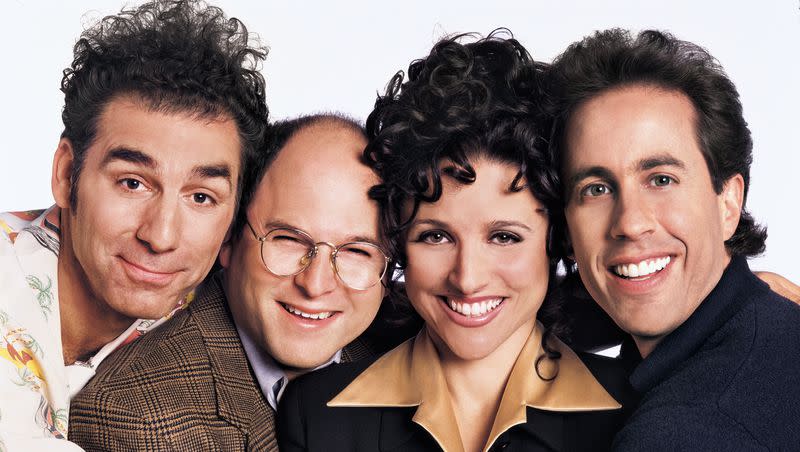In age where sitcoms have died and strikes will change fall TV, is it time to rewatch ‘Seinfeld?’

- Oops!Something went wrong.Please try again later.
The finale for “Seinfeld” attracted a monster-sized audience of 76.3 million people when it premiered in 1998.
It was before the age of streaming, so viewers collected in their living rooms around a clunky TV to watch as “the show about nothing” came to an end. Two other sitcoms, M*A*S*H and Cheers had even greater viewership, according to Insider.
It’s worth asking why contemporary shows are absent from the top 20 most watched show finales list. Recent finale viewership numbers just haven’t stacked up to series like “Friends” and “Full House.”
The ongoing strikes in Hollywood will shake up fall television, so why not look back at some of the classics? Here’s a deeper look at how streaming services changed television and why sitcoms used to be so popular.
Related
How did streaming services impact TV?
Streaming disrupted the television world because instead of having to huddle around a TV at a certain hour to watch your favorite show, a streaming service might have it so you can watch in an instant.
At this point in time, more people watch streaming services than they do cable, according to Ars Technica. This means the experience of watching television has changed.
While the immediacy streaming services have provides customers with more options and convenience, it was really something to watch television finales. People in all different places, of all different politics, of all different stations would share the common experience of watching a finale. A similar sense of universality could be found in movie theaters — it’s harder to rent from Blockbuster than it is to stream on Netflix, so movie theaters provided a unique experience.
Now television faces another disruption — the strikes. The ongoing writers strike and recent acting strike have brought Hollywood to something of a halt. Backlogs will eventually run dry if the strikes go on and plenty of shows that may have premiered in the fall may no longer be able to, according to Vulture’s Jason P. Frank.
International shows, streaming shows, soap operas and reality TV won’t experience the effects of the strikes in the same way that scripted shows do. So, maybe it’s time to revisit some of the great American sitcoms this fall.
Related
What is a sitcom?
A sitcom, in short, is a situational comedy. “Often the characters are markedly different types thrown together by circumstance and occupying a shared environment such as an apartment building or a workspace,” per Britannica.
“Friends,” “Seinfeld,” “I Love Lucy,” “Curb Your Enthusiasm,” “The King of Queens,” “Cheers,” “Everybody Hates Chris,” “Everybody Loves Raymond” and “That ‘70s Show” are among the most popular and influential sitcoms in the history of American television and they’re generally available on streaming service.
For example, “Friends” is on Max, “Seinfeld” is on Netflix, “I Love Lucy” is on Paramount+.
It’s also worth noting several sitcoms are rated TV-PG or sometimes even TV-G, which makes it easier for an audience sensitive to graphic and mature content to navigate. Part of the reason why sitcoms didn’t approach higher ratings was because they were designed to be watched as a family.
And that may have contributed to their popularity.
Why were sitcoms so popular?
Sitcoms often involve humor, which likely contributed to their success. But there’s something to the parasocial relationships they create.
Take “Seinfeld” as an experience. “Seinfeld” revolves around a group of friends who often frequent the same old cafe and the show sticks close to what’s plausible to happen in reality. That means the show is relatable and universal — traits that bode well for an audience.
“A sitcom can become part of our lives in a way that even a quality show like “Mad Men” does not. “Mad Men” isn’t really “ours” because it is not our story; rather, it shows us who we want to be and what we are not. The sitcom is “ours” because it comes closer to showing us who we are,” Jake Martin wrote for America Magazine.
It’s possible that sitcoms could be more reliant on the earlier model of watching television — the one where everyone was gathered in the same room.
“We watched these shows together as a family, in the same room, but we don’t have that anymore. The way we watch TV is different. Someone’s watching a show on their computer in bed while someone else is watching something from the couch in the living room,” TV advertising professional Terrence Moss told The Chicago Tribune.
But now shows have changed.
“The last show my family watched together was ‘The Fresh Prince of Bel Air.’ It was a Black sitcom, so that appealed to us. My father could relate to Uncle Phil, and I had Will Smith and Carlton, so there was something that appealed to everybody. And right now, it’s not about mass appeal anymore. It’s about the niche,” Moss said to The Chicago Tribune.
What could be gained from returning to watching sitcoms? Well, what if we even started watching television together again at the same time?
It was once a universal experience capable of creating unity. Maybe it can be that again.

